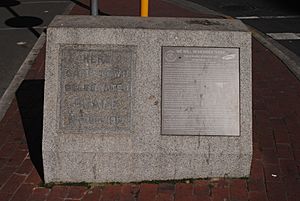Two-minute silence facts for kids
The two-minute silence is a special time of quiet remembrance. It happens every year on Remembrance Day, November 11th, at 11:00 AM. People in the United Kingdom and other Commonwealth countries observe it to honor those who died in wars and conflicts. This moment of silence marks the exact time in 1918 when World War I officially ended. It's also observed on Remembrance Sunday.
Contents
Why We Have the Two-Minute Silence
The Idea from South Africa
The idea for the two-minute silence started in Cape Town, South Africa. In 1918, the Mayor of Cape Town, Sir Harry Hands, began a daily two-minute silent pause. This happened after his son died in the war.
The silence was signaled by the firing of the Noon Gun on Signal Hill. For one minute, people gave thanks for those who came home safely. The second minute was to remember those who had died. During this time, traffic stopped, and people paused what they were doing. A bugler played "Last Post" to start the silence and "Reveille" to end it. This daily event lasted for a full year.
News of this special silence reached London through a Reuters reporter. Soon, other towns in England, Canada, and Australia started similar traditions. Today, a plaque in Adderley Street in Cape Town remembers this important beginning.
Sir Percy Fitzpatrick's Role
Sir Percy Fitzpatrick, a South African, was deeply moved by the daily silence in Cape Town. His own son had died in France during the war. In 1919, he wanted this moment of silence to be observed every year across the entire British Empire.
He wrote to Lord Milner, a British official, explaining how powerful the silence in Cape Town was. Sir Percy believed this silence was important for everyone:
- For the women who had lost loved ones.
- For the children to understand the cost of their freedom.
- For the men who served.
- Most importantly, for the brave people who gave their lives.
King George V Makes it Official
Lord Milner shared Sir Percy's idea with Lord Stamfordham, who was King George V's private secretary. The King loved the idea. On November 5, 1919, the King's government quickly approved it.
On November 7, 1919, a statement from Buckingham Palace was published in The Times newspaper. King George V asked all his people to observe a two-minute silence. He wanted everyone to pause at 11:00 AM on November 11th. This was to remember the end of World War I and honor those who died. He said that during these two minutes, "all work, all sound, and all locomotion should cease." This was so everyone could focus on remembering the "glorious dead."
How to Observe the Silence
The Royal British Legion suggests a specific way to observe the two-minute silence:
- At 11:00 AM, the "Last Post" is played.
- Then, a special reading called the "exhortation" is read aloud.
- The Two-Minute Silence then begins.
- The silence ends when "The Rouse" is played.
The exhortation is a powerful quote from the Ode of Remembrance: "They shall grow not old, as we that are left grow old, Age shall not weary them, nor the years condemn. At the going down of the sun, and in the morning, We will remember them." The response is: "We will remember them."
This order is often used in ceremonies across the Commonwealth.
See also
- Armistice Day
- Moment of Silence
- Remembrance Day
- Silent Minute


